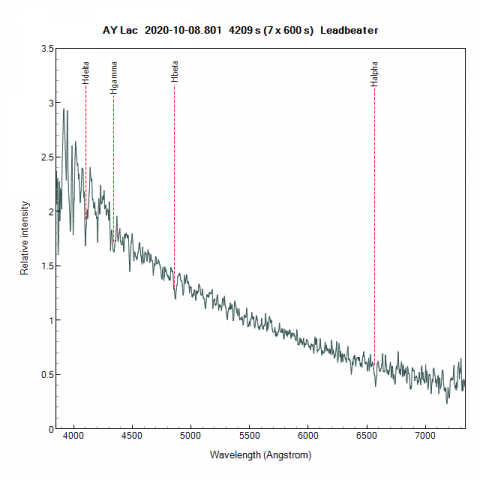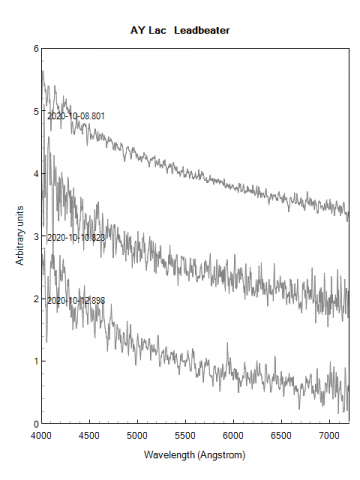› Forums › Variable Stars › AY Lac
- This topic has 14 replies, 8 voices, and was last updated 5 years, 2 months ago by
 Robin Leadbeater.
Robin Leadbeater.
-
AuthorPosts
-
8 October 2020 at 12:36 pm #574754
 Gary PoynerParticipant
Gary PoynerParticipantThis object (catalogued as a NR or UGWZ – Recurrent Nova or Dwarf Nova of the WZ Sge type) has been detected in outburst by ASAS-SN on Oct 08.283 at 13.83g. Only two previous outbursts have been recorded, 1927 & 1966.
It’s position is RA 22 22 22.10 Dec +50 23 40.0
Photometry, astrometry and spectroscopy are urgently required. Please report your observations to BAAVSS and/or AAVSO.
A finder chart can be obtained from the AAVSO Chart Plotter here
Gary
8 October 2020 at 7:48 pm #583222 Jeremy ShearsParticipant
Jeremy ShearsParticipantJust observed:
AY Lac Oct 8.778 13.83C
8 October 2020 at 11:11 pm #583223 David SwanParticipant
David SwanParticipantAn image of the nova. Lots of stars around here!
Image details: Centre RA 22h 22m 32.3s, Dec +50° 23′ 42.5″; Pos Angle +316° 35.2′; FL 196.3 mm; 2.52″/Pixel
8 October 2020 at 11:40 pm #583224 Robin LeadbeaterParticipant
Robin LeadbeaterParticipantALPY 600 ~12A resolution. A blue continuum with weak Balmer absorption
 9 October 2020 at 12:00 am #583225
9 October 2020 at 12:00 am #583225 Nick JamesParticipant
Nick JamesParticipantIndeed. A very starry field. I get a position of 22 22 22.17 +50 23 40.0 (J2000) using Gaia DR2.
9 October 2020 at 3:56 am #583227John O’Neill
ParticipantGary, thanks for the heads up. I made it (visually) mag 13.9 on 2020 Oct 9 at 01:38 UT. I used the AAVSO chart. Yes, it is a rich field, but easy enough.
John
9 October 2020 at 9:34 am #583228 Gary PoynerParticipant
Gary PoynerParticipantGood to see reports of AY Lac coming in, and that the outburst coincided with clear sky for some people – me included. I had AY Lac varying between 13.8-14.1 visually over several hours, but after spending decades looking at empty space it was a thrill just to see it.
Gary
9 October 2020 at 2:54 pm #583229 Mike HarlowSpectator
Mike HarlowSpectatorHi Gary,
Interesting stuff. Any references to the previous outbursts available online? Curious to known if the 1927 and 1966 outbursts evolved in the same way or were they significantly different from each other?
Thanks,
Mike.
9 October 2020 at 3:18 pm #583230 Gary PoynerParticipant
Gary PoynerParticipantHi Mike,
Not a lot available, but this is interesting…
https://konkoly.hu/pub/ibvs/5401/5441.pdf
Gary
10 October 2020 at 11:28 am #583232 Jeremy ShearsParticipant
Jeremy ShearsParticipantA little fainter last night: Oct 9.852 at ~14.17C
10 October 2020 at 11:36 pm #583231 Grant PrivettParticipant
Grant PrivettParticipantI did my first variable star measurement in 30 years.
Result: 20201009 01:27 Mag=14.1 (first crude estimate using AAVSO) while AA7 says 13.94. What does everyone else use?
Refined result using Gaia DR2 plus another from the following night…
20201009 01:27 2459131.60262 14.05
20201010 00:21 2459132.51466 14.30
12 October 2020 at 11:38 pm #583236 Robin LeadbeaterParticipant
Robin LeadbeaterParticipantA short clear spell tonight. Not long enough to get a spectrum but off the spectrograph guider it looked about a magnitude fainter than on 8th
13 October 2020 at 2:38 pm #583238 Gary PoynerParticipant
Gary PoynerParticipantI had it 15.0 visual this morning (13th).
I was hoping that it might do more (we have waited rather a long time to see it after all!). I don’t see any evidence for superhump like features in the light curve at all. Perhaps it might surprise us with a second outburtst once it’s faded further.
One of the earlier interpretations of it’s class is Recurrent Nova. Maybe?
Gary
14 October 2020 at 12:36 pm #583243 Robin LeadbeaterParticipant
Robin LeadbeaterParticipantInteresting. The spectrum seems consistent with a dwarf nova outburst. I managed to salvage a couple of short exposure spectra from aborted runs on the 10th and 12th. They are very noisy though so the only significant feature is the hot continuum shape.
Robin
 17 October 2020 at 1:24 pm #583249
17 October 2020 at 1:24 pm #583249 Robin LeadbeaterParticipant
Robin LeadbeaterParticipantAnother spectrum on a better night (2hr 20min exposure at mag ~15.5 The limit at this resolution). Not much happening compared with a week ago
https://britastro.org/specdb/data_graph.php?obs_id=8021%2C8002&multi=yes
Robin
-
AuthorPosts
- You must be logged in to reply to this topic.
